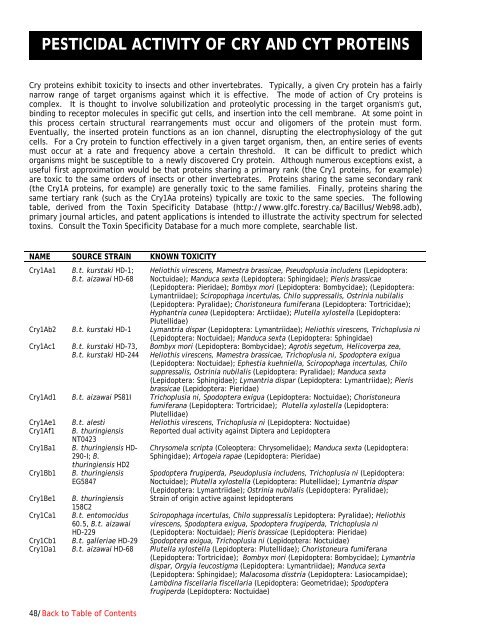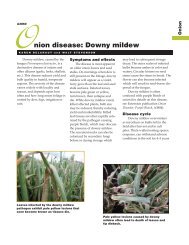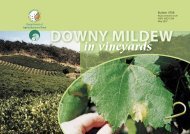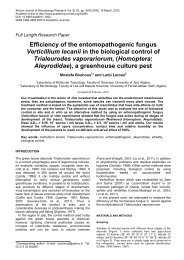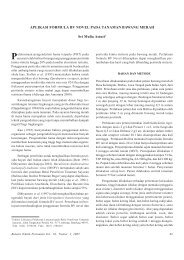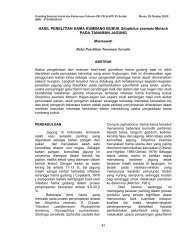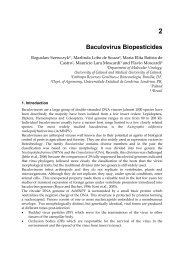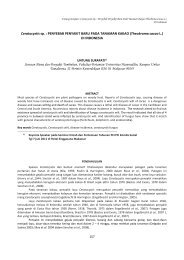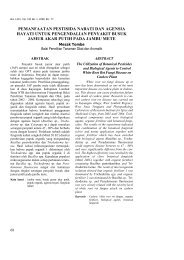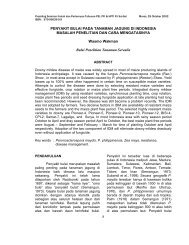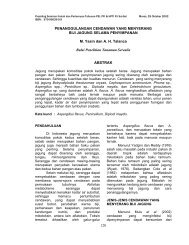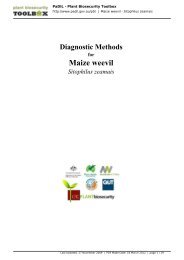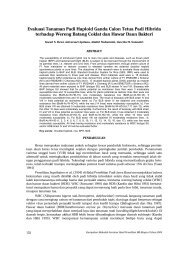PESTICIDAL ACTIVITY OF CRY AND CYT PROTEINSCry proteins exhibit toxicity to insects and other invertebrates. Typically, a given Cry protein has a fairlynarrow range <strong>of</strong> target organisms against which it is effective. The mode <strong>of</strong> action <strong>of</strong> Cry proteins iscomplex. It is thought to involve solubilization and proteolytic processing in the target organism's gut,binding to receptor molecules in specific gut cells, and insertion into the cell membrane. At some point inthis process certain structural rearrangements must occur and oligomers <strong>of</strong> the protein must form.Eventually, the inserted protein functions as an ion channel, disrupting the electrophysiology <strong>of</strong> the gutcells. For a Cry protein to function effectively in a given target organism, then, an entire series <strong>of</strong> eventsmust occur at a rate and frequency above a certain threshold. It can be difficult to predict whichorganisms might be susceptible to a newly discovered Cry protein. Although numerous exceptions exist, auseful first approximation would be that proteins sharing a primary rank (the Cry1 proteins, for example)are toxic to the same orders <strong>of</strong> insects or other invertebrates. Proteins sharing the same secondary rank(the Cry1A proteins, for example) are generally toxic to the same families. Finally, proteins sharing thesame tertiary rank (such as the Cry1Aa proteins) typically are toxic to the same species. The followingtable, derived from the Toxin Specificity Database (http://www.glfc.forestry.ca/<strong>Bacillus</strong>/Web98.adb),primary journal articles, and patent applications is intended to illustrate the activity spectrum for selectedtoxins. Consult the Toxin Specificity Database for a much more complete, searchable list.NAME SOURCE STRAIN KNOWN TOXICITYCry1Aa1 B.t. kurstaki HD-1;B.t. aizawai HD-68Heliothis virescens, Mamestra brassicae, Pseudoplusia includens (Lepidoptera:Noctuidae); Manduca sexta (Lepidoptera: Sphingidae); Pieris brassicae(Lepidoptera: Pieridae); Bombyx mori (Lepidoptera: Bombycidae); (Lepidoptera:Lymantriidae); Sciropophaga incertulas, Chilo suppressalis, Ostrinia nubilalis(Lepidoptera: Pyralidae); Choristoneura fumiferana (Lepidoptera: Tortricidae);Hyphantria cunea (Lepidoptera: Arctiidae); Plutella xylostella (Lepidoptera:Plutellidae)Cry1Ab2 B.t. kurstaki HD-1 Lymantria dispar (Lepidoptera: Lymantriidae); Heliothis virescens, Trichoplusia niCry1Ac1B.t. kurstaki HD-73,B.t. kurstaki HD-24448/Back to Table <strong>of</strong> Contents(Lepidoptera: Noctuidae); Manduca sexta (Lepidoptera: Sphingidae)Bombyx mori (Lepidoptera: Bombycidae); Agrotis segetum, Helicoverpa zea,Heliothis virescens, Mamestra brassicae, Trichoplusia ni, Spodoptera exigua(Lepidoptera: Noctuidae); Ephestia kuehniella, Sciropophaga incertulas, Chilosuppressalis, Ostrinia nubilalis (Lepidoptera: Pyralidae); Manduca sexta(Lepidoptera: Sphingidae); Lymantria dispar (Lepidoptera: Lymantriidae); Pierisbrassicae (Lepidoptera: Pieridae)Cry1Ad1 B.t. aizawai PS81I Trichoplusia ni, Spodoptera exigua (Lepidoptera: Noctuidae); Choristoneurafumiferana (Lepidoptera: Tortricidae); Plutella xylostella (Lepidoptera:Plutellidae)Cry1Ae1 B.t. alesti Heliothis virescens, Trichoplusia ni (Lepidoptera: Noctuidae)Cry1Af1Cry1Ba1Cry1Bb1B. thuringiensisNT0423B. thuringiensis HD-290-I; B.thuringiensis HD2B. thuringiensisEG5847Reported dual activity against Diptera and LepidopteraChrysomela scripta (Coleoptera: Chrysomelidae); Manduca sexta (Lepidoptera:Sphingidae); Artogeia rapae (Lepidoptera: Pieridae)Spodoptera frugiperda, Pseudoplusia includens, Trichoplusia ni (Lepidoptera:Noctuidae); Plutella xylostella (Lepidoptera: Plutellidae); Lymantria dispar(Lepidoptera: Lymantriidae); Ostrinia nubilalis (Lepidoptera: Pyralidae);Strain <strong>of</strong> origin active against lepidopteransCry1Be1 B. thuringiensis158C2Cry1Ca1 B.t. entomocidus Sciropophaga incertulas, Chilo suppressalis Lepidoptera: Pyralidae); Heliothis60.5, B.t. aizawai virescens, Spodoptera exigua, Spodoptera frugiperda, Trichoplusia niHD-229(Lepidoptera: Noctuidae); Pieris brassicae (Lepidoptera: Pieridae)Cry1Cb1 B.t. galleriae HD-29 Spodoptera exigua, Trichoplusia ni (Lepidoptera: Noctuidae)Cry1Da1 B.t. aizawai HD-68 Plutella xylostella (Lepidoptera: Plutellidae); Choristoneura fumiferana(Lepidoptera: Tortricidae); Bombyx mori (Lepidoptera: Bombycidae); Lymantriadispar, Orgyia leucostigma (Lepidoptera: Lymantriidae); Manduca sexta(Lepidoptera: Sphingidae); Malacosoma disstria (Lepidoptera: Lasiocampidae);Lambdina fiscellaria fiscellaria (Lepidoptera: Geometridae); Spodopterafrugiperda (Lepidoptera: Noctuidae)
NAME SOURCE STRAIN KNOWN TOXICITYCry1Ea1 B.t. darmstadiensisHD-146Spodoptera littoralis, Spodoptera exempta (Lepidoptera: Noctuidae); Manducasexta (Lepidoptera: Sphingidae)Cry1Eb1 B.t. aizawai Source strain is toxic to Trichoplusia ni, Spodoptera exigua (Lepidoptera:Noctuidae); Plutella xylostella (Lepidoptera: Plutellidae)Cry1Fa1 B.t. aizawai EG6346 Plutella xylostella (Lepidoptera: Plutellidae); Heliothis virescens, Spodopteraexigua, Spodoptera littoralis (Lepidoptera: Noctuidae); Ostrinia nubilalis(Lepidoptera: Pyralidae)Cry1Ia1Cry1Ib1Cry1Ja1B.t. kurstaki INA-02,4835B.t. entomocidusBP465B. thuringiensisEG5847Spodoptera littoralis (Lepidoptera: Noctuidae); Bombyx mori (Lepidoptera:Bombycidae); Plutella xylostella (Lepidoptera: Plutellidae); Ostrinia nubilalis(Lepidoptera: Pyralidae); Leptinotarsa decemlineata (Coleoptera: Chrysomelidae)Plutella xylostella (Lepidoptera: Plutellidae)Helicoverpa zea, Heliothis virescens, Pseudoplusia includens, Spodoptera exigua,Spodoptera frugiperda, Trichoplusia ni (Lepidoptera: Noctuidae); Plutellaxylostella (Lepidoptera: Plutellidae)Pseudoplusia includens, Trichoplusia ni (Lepidoptera: Noctuidae); Ostrinianubilalis (Lepidoptera: Pyralidae); Plutella xylostella (Lepidoptera: Plutellidae)Cry1Jb1 B. thuringiensisEG5092Cry1Ka1 B.t. morrisoni BF190 Artogeia rapae (Lepidoptera: Pieridae)Cry2Aa1 B.t. kurstaki HD-1,HD-263Sciropophaga incertulas, Chilo suppressalis, Ostrinia nubilalis (Lepidoptera:Pyralidae); Lymantria dispar (Lepidoptera: Lymantriidae); Helicoverpa armigera,Heliothis virescens, Trichoplusia ni (Lepidoptera: Noctuidae); Aedes aegypti(Diptera: Cuclidae)Cry2Ab1 B.t. kurstaki HD1 Manduca sexta (Lepidoptera: Sphingidae)Cry2Ac1 B. thuringiensis S1 Heliothis virescens, Trichoplusia ni (Lepidoptera: Noctuidae); Manduca sexta(Lepidoptera: Sphingidae)Cry3Aa1B.t. san diego, B.t.tenebrionisHaltica tombacina, Leptinotarsa decemlineata, Pyrrhalta luteola (Coleoptera:Chrysomelidae); Hypera brunneipennis, Otiorhynchus sulcatus, Anthonomusgrandis (Coleoptera: Curculionidae); Tribolium castaneum, Tenebrio molitor(Coleoptera: Tenebrionidae)Cry3Ba1 B.t. tolworthi Leptinotarsa decemlineata (Coleoptera: Chrysomelidae)EG2838Cry3Bb1 B.t. kumamotoensis Leptinotarsa decemlineata (Coleoptera: Chrysomelidae)EG4961Cry3Ca1 B.t. san diego Pyrrhalta luteola (Coleoptera: Chrysomelidae)Cry4Aa1 B.t. israelensis 4Q2- Anopheles stephensi, Aedes aegypti, Culex pipiens (Diptera: Cuclidae)72Cry4Ba1 B.t. israelensis 4Q2- Aedes aegypti (Diptera: Cuclidae)72Cry5Aa1 B. thuringiensis Caenorhabditis elegens, Pratylenchus spp. (plant parasitic nematodes)PS17ACry5Ab1 B. thuringiensis PS7 Fasciola hepatica (liver fluke); Caenorhabditis elegens, Pratylenchus spp. (plantparasitic nematodes)Cry6Aa1 B. thuringiensis Pratylenchus spp., Panagrellus redivivus (plant pathogenic nematodes)PS52A1Cry6Ba1 B. thuringiensis Pratylenchus spp. (plant pathogenic nematode)PS52A1Cry7Aa1 B. thuringiensis Leptinotarsa decemlineata (Coleoptera: Chrysomelidae)BTS137JCry8Aa1 B.t. kumamotoensis Leptinotarsa decemlineata (Coleoptera: Chrysomelidae)PS50CCry8Ba1 B.t. kumamotoensis Cotinis spp. (Coleoptera: Scarabaeidae)PS50CCry8Ca1 B.t. japonensis Anomala cuprea (Coleoptera: Scarabaeidae)strain BuibuiCry9Aa1 B.t. galleriae 11-67 Galleria mellonella (Lepidoptera: Pyralidae )Cry9Ca1 B.t. tolworthi H9 Agrotis segetum, Helicoverpa armigera, Heliothis virescens, Mamestra brassicae,Spodoptera exigua, Spodoptera littoralis (Lepidoptera: Noctuidae); Manduca sexta(Lepidoptera: Sphingidae); Ostrinia nubilalis (Lepidoptera: Pyralidae); Plutellaxylostella (Lepidoptera: Plutellidae); Bombyx mori (Lepidoptera: Bombycidae);Choristoneura fumiferana (Lepidoptera: Tortricidae)Cry10Aa1 B.t. israelensis Aedes aegypti (Diptera: Cuclidae)ONR60ACry11Aa1 B.t. israelensis HD- Anopheles stephensi, Aedes aegypti, Culex pipiens (Diptera: Cuclidae)567Cry11Ba1 B.t. jegathesan 367 Anopheles stephensi, Aedes aegypti, Culex pipiens (Diptera: Cuclidae)Cry11Bb1 B.t. medellin Anopheles albimanus, Aedes aegypti, Culex quinquefasciatus (Diptera: Cuclidae)49/Back to Table <strong>of</strong> Contents
- Page 1 and 2: Bacillus&thuringiensisBacilluscereu
- Page 3 and 4: TABLE OF CONTENTSTable of Contents
- Page 5 and 6: What you can do to help the BGSCOur
- Page 7 and 8: Volunteer SpotlightClaire McHughCla
- Page 9 and 10: Serotype 6—Serovar. entomocidus/s
- Page 11 and 12: Serotype 17—Serovar. tohokuensisB
- Page 13 and 14: Serotype 3a, 3d—Serovar. sumiyosh
- Page 15 and 16: Serotype 45—Serovar. roskildiensi
- Page 17 and 18: Serotype 18a, 18c—Serovar. yosooB
- Page 19 and 20: B. THURINGIENSIS STRAINS BY SEROTYP
- Page 21 and 22: E. COLI CLONES OF B. THURINGIENSIS
- Page 23 and 24: BACTERIOPHAGES OF B. CEREUS & B. TH
- Page 25 and 26: SELECTED CLONING VECTORS AND HOSTSB
- Page 27 and 28: MEDIA FOR GROWTH AND SPORULATION2×
- Page 29 and 30: G-Tris MediumAronson, A. I., et al.
- Page 31 and 32: Electroporation ProtocolAdapted fro
- Page 33 and 34: GENERALIZED TRANSDUCTION WITH CP-54
- Page 35 and 36: References1. Andrup, L., J. Damgaar
- Page 37 and 38: Purification of Crystals in a Separ
- Page 39 and 40: Table 2. Sequences of the PCR prime
- Page 41 and 42: NOMENCLATURE FOR CRY AND CYT PROTEI
- Page 43 and 44: NAME ORIGINAL ACCESSION NUMBER(S) C
- Page 45 and 46: 23. Donovan, W. P., J. M. González
- Page 47 and 48: 66. Masson, L., A. Mazza, L. Gringo
- Page 49: diptera-specific insecticidal endot
- Page 53 and 54: Phylogram of Cry and Cyt Holotype S
- Page 55 and 56: • What is the mode of action of C
- Page 57 and 58: GENERAL INDEX OF STRAINS, PHAGE AND


